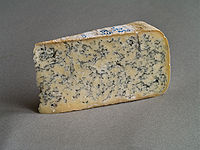
Photo from wikipedia
The strains capable of degrading cellulose have attracted much interest because of their applications in straw resource utilization in solid-state fermentation (SSF). However, achieving high spore production in SSF is… Click to show full abstract
The strains capable of degrading cellulose have attracted much interest because of their applications in straw resource utilization in solid-state fermentation (SSF). However, achieving high spore production in SSF is rarely reported. The production of spores from Streptomyces griseorubens JSD-1 was investigated in shaker-flask cultivation in this study. The optimal carbon, organic nitrogen and inorganic nitrogen sources were sucrose, yeast extract and urea, respectively. Plackett–Burman design (PBD) was adopted to determine the key medium components, and the concentration levels of three components (urea, NaCl, MgSO 4 ·7H 2 O) were optimized with the steepest ascent path and central composite design (CCD), achieving 1.72 × 10 9 CFU/g of spore production. Under the optimal conditions (urea 2.718% w/v , NaCl 0.0697% w/v , MgSO 4 ·7H 2 O 0.06956% w/v ), the practical value of spore production was 1.69 × 10 9 CFU/g. The determination coefficient (R 2 ) was 0.9498, which ensures an adequate credibility of the model.
Journal Title: Sustainability
Year Published: 2020
Link to full text (if available)
Share on Social Media: Sign Up to like & get
recommendations!